How to Solo Like Angus Young, Jimmy Page and Tony Iommi
An in-depth study of the playing styles of three legends of hard-rock guitar.
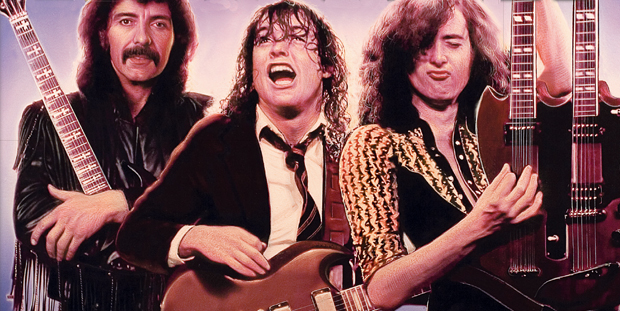
Regarded by many as the three most vital purveyors of pure hard rock/heavy metal sonic evil, AC/DC’s Angus Young, Led Zeppelin’s Jimmy Page and Black Sabbath’s Tony Iommi have each forged a distinct, instantly recognizable guitar style and sound.
After decades of dedicated service, all three players continue to influence countless up-and-coming metalheads the world over, and an in-depth study of each guitarist’s distinct musical personality is mandatory for any aspiring hard rock player.
Young, Page and Iommi share a few similarities in their respective crafts.
All three have relied on Gibson solidbody/dual-humbucker-style guitars for the majority of their careers, inspiring signature models of their respective axes: Angus Young has favored Gibson SG-type guitars and has his own Gibson signature model; Jimmy Page is most closely associated with the 1959 sunburst Les Paul, replicated in limited quantity by Gibson (with a retail price of more than $20,000); and Tony Iommi’s long association with the ’61 SG led to the creation of the similarly designed Gibson Tony Iommi model (as well as the custom-made SG-type Patrick Eggle and JayDee models that Iommi also uses). When soloing, all three guitarists most often use the bridge pickup.
Armed with their respective axes, the three defined the sound of metal in the late Sixties and early Seventies by relying on specific amplification: Jimmy Page favors Marshall SLP-1959 100-watt amps modified with KT-88 tubes, while also employing Voxes, Hiwatts, Fender Super Reverbs and Orange amps.
Angus Young has generally used Marshall 100-watt “Plexi” models along with JTM-45 “Plexis.” Iommi is also known for his use of Marshall and Orange gear and has long been a fan of Laney amplification; he even has his own Laney 100-watt signature amplifier.
Another commonality among the three guitar gods is their choice of scale for soloing. In the spirit of their American blues guitar heroes, all three rely most heavily on the minor pentatonic scale. FIGURE 1a shows the A minor pentatonic scale (A C D E G) played in fifth position; FIGURE 1b shows the same scale as played in an extended pattern that traverses the neck from the third fret to the 12th. The root notes are circled in each figure; once you have become familiar with these fingering patterns, be sure to move them to all other keys.

Let’s now look at these two patterns one octave and 12 frets higher: FIGURE 2a depicts A minor pentatonic played in 17th position while FIGURE 2b shows an extended pattern that spans the 15th–22nd frets, ending with a whole step bend from D to E. Young, Page and Iommi all cover the highest reaches of the neck in many of their solos, so be sure to practice the minor pentatonic scales in every key and all over the fretboard.
Angus Young

With his comedic school-boy outfit and hyperenergetic stage antics, Angus Young has been both celebrated and reviled for his over-the-top persona. But in truth, he is simply one of the greatest rock soloists ever. His intense, exciting playing style is equal parts adrenaline, blues rock fire, and precision, all of it spiked with a crash-and-burn attitude. In other words, it’s hard rock at its absolute best.
One of Young’s greatest solos is the one he recorded in the AC/DC classic, “You Shook Me All Night Long” (Back in Black). FIGURE 3 presents a solo played in this style: it’s played over a repeating I-IV-V-IV chord progression in the key of G—G-C-D-C—and is based primarily on the G minor pentatonic scale (G Bb C D F); bars 1–4 are played in third position, and then the next phrase shifts one octave higher to 15th position in bars 5–8.
The figure begins with a whole-step bend from C to D on the G string that is sustained and played with vibrato for three beats. Use your ring finger to fret the note and both your ring and middle fingers to push the string, with the middle finger one fret behind the ring finger. This two-finger bending technique is known as reinforced fingering and is used extensively by Young as well as Page and Iommi.
The first note in FIGURE 3 is a prime example of Young’s signature bend vibrato: upon bending the string with the ring and middle fingers (the index finger may also be used to help push the string for additional strength and support), the bend is then repeatedly released partially—somewhere between a quarter step and a half step—and restored to a whole step (“full”) in quick, even rhythm.
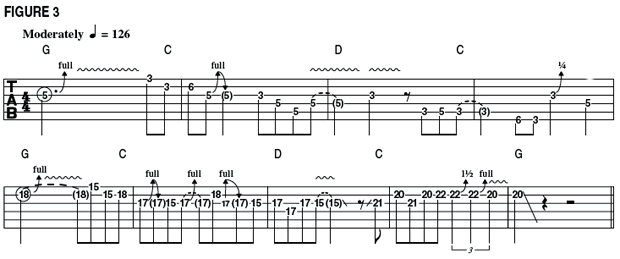
When executing this type of bend vibrato, you’ll find that it helps to push your fret-hand thumb against the top side of the neck, as this provides leverage for the fingers that are pushing and releasing the string. Young’s vibrato is relatively fast and not very wide and will require practice and keen listening to emulate authentically.
The C-to-D bend is followed with an index-finger barre across the top two strings at the third fret, and in bar 2 the pinkie frets F (second string/sixth fret), followed by the same reinforced ring-finger bend and release on C (third string/fifth fret). At the end of bar 2, after fretting the G note, roll the tip of the ring finger from the fourth string over to the fifth string and then back. This “finger roll” may take some practice to get used to, but it’s a very useful technique that is worth learning.
What makes a solo like this great is its simplicity and melodic quality. Each idea is balanced against the next in an effortless way, and the overall result is a memorable solo that one could easily sing—an earmark of every great hard rock guitar solo.
Beginning in bar 5 of FIGURE 3, the second half of the solo relates to the first half in that it also leads off with a sustained bend, this time from a high F, the flatted seventh, to G, the root note, which is played vibrato in a similar manner. When playing minor pentatonic licks like these in high positions, many blues, blues/rock and hard rock players adopt a three-finger approach—index-middle-ring—for the majority of their licks, presumably because of the closeness of the frets. Young, however, chooses to use his pinkie in many of his licks, regardless of his fretboard position.
I wrap the solo up in bar 8 by switching to a riff based on G major pentatonic (G A B D E). A staple of blues soloing is to alternate between the “sweet” sound of major pentatonic and the darker sound of minor pentatonic, and Young does just this in many of his solos.
Another great example of Young’s masterful soloing can be heard on the title track to Back in Black. FIGURE 4 shows a solo played in a similar style. This example is played over a simple repeating chord progression in the key of E: E-D-A (I-fVII-IV). The majority of the solo is based on the E minor pentatonic scale (E G A B D), although I begin with a phrase that incorporates notes from the E Dorian mode (E F# G A B C# D) by including the sixth, C#. The placement of this pitch is critical in relation to the accompanying chord progression, as it lands on the A chord, and C# is the major third of A.
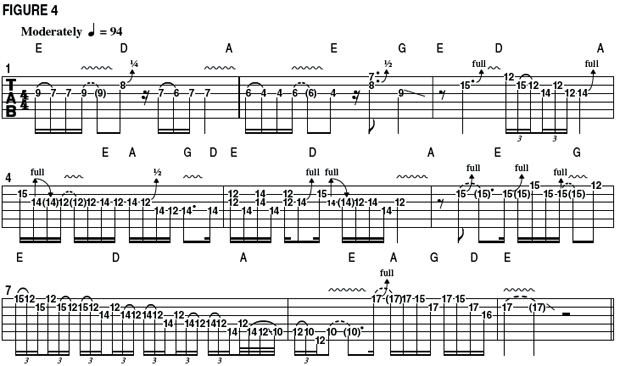
Like FIGURE 3, the goal with this example is to illustrate Young’s clear sense of melody and melodic development: FIGURE 4 begins with a “hooky” phrase that is developed by descending the G string in a similar manner across the first two bars. At bar 3, I jump up to the 12th-position E minor pentatonic “box” pattern, beginning with a high D-to-E bend and vibrato that is sustained through the first two beats of the bar, followed by a fast phrase based on descending 16th-note triplets.
The solo then stays rooted in 12th position through the remainder of bar 3, all the way to the end of bar 7. As with the high-position pentatonic licks in the previous example, the majority of these licks may be played comfortably with three fingers.
Particularly noteworthy is the classic lightning-fast blues/rock/metal run that spans bar 7 of FIGURE 4: based entirely on descending 16th-note triplets, the run begins with a pull-off from a high G (first string/15th fret) to E (12th fret) followed by D (second string/15th fret). The next 16th-note triplet starts one note lower, on E, and is followed by a pull-off from D to B (15th fret to 12th fret). The pattern of starting one note lower with each subsequent 16th-note triplet and using pull-offs wherever possible is repeated throughout the run.
As the solo develops, analyze each beat and notice how the progression of the lines contributes to the overall phrase. Young is a master of “phrase-ology,” a skill/gift that lends an almost effortless quality to his solos and the feeling of constantly pushing the music forward and telling a story.
JIMMY PAGE
Jimmy Page was inspired by many of the same American blues guitar heroes as his British blues/rock contemporaries Eric Clapton, Jeff Beck and Peter Green. These heroes include the three Kings—Albert, B.B. and Freddie—as well as T-Bone Walker, Buddy Guy and Otis Rush.
Page was also equally influenced by the fiery intensity of rockabilly guitarists Cliff Gallup (Gene Vincent and the Blue Caps) and Scotty Moore (Elvis Presley), as well as the futuristic daring of Les Paul. A student of many different styles of guitar playing, Page always combines in his solos a well-balanced structure and sense of melodic development with true depth of feeling. His progressive approach to soloing has pushed the nature of blues/rock guitar to previously unimagined territory.
FIGURE 5 is an eight-bar solo representative of Page’s improvisation style. It’s played in the key of A minor over a repeating Am-G-F (i-bVII-bVI) chord progression. The majority of the solo is based on A minor pentatonic (A C D E G), beginning in fifth position with a D-to-E bend on the G string. This note is bent and shaken using the same reinforced fingering and thumb leveraging techniques described earlier in reference to FIGURE 3.
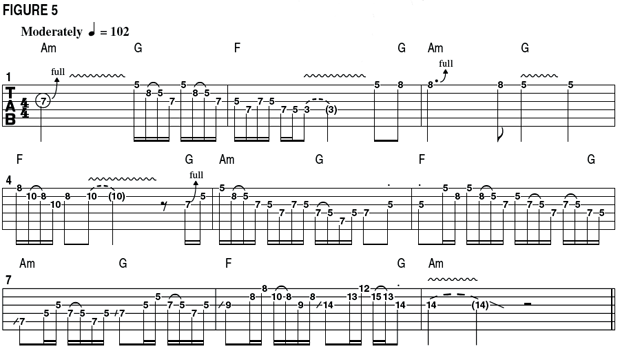
This initial bend is followed by a stream of cascading 16th notes played across the next four beats on the top three strings, with notes quickly alternating between either the fifth and seventh frets or the fifth and eighth frets. Through the majority of this solo, a balance of eighth and 16th notes is achieved, giving the solo a forward-leaning quality as each phrase flows seamlessly into the next.
Over an F chord in bars 2, 4, 6 and 8, I occasionally incorporate an F note into the A minor pentatonic-derived lines in order to clearly relate the solo line to the backing chord progression; this approach is a Page trademark. Adding this one note also serves to broaden the solo beyond the strict blues territory while also strengthening the melodic quality of the licks.
Bar 5 begins with a descending run wherein a stream of 16th notes are phrased in two six-note groups that form an interesting melodic contour. A similar phrasing approach is used in bar 6 with successive four-note descending groups. The solo develops interestingly and builds to a climax in bars 7 and 8 with a repeated melodic “shape” that ascends the A minor pentatonic scale in seven-note phrases, starting from either the root note or the fifth each time.
While this may sound overly analyzed, in truth it is the application of these melodic phrasing techniques that gives the solo its clear sense of structure, which is a hallmark of all of Page’s best lead work.
TONY IOMMI
As the progenitor of the heaviest of heavy metal, Tony Iommi set high standards for the writing of demonic-sounding riffs while he simultaneously created the template for the heavy metal soloing of future generations.
As a teenager, Iommi, a left-handed player, was the victim of an unfortunate accident in which he lost the tips of his right hand’s middle and ring fingers while working in a sheet metal factory. Discouraged but not defeated, the resourceful guitarist devised plastic covers made from bottle caps to wear over those fingertips.
In later years, he would wear custom–fitted leather finger protectors. Iommi also switched to using super light-gauge strings: .008, .008, .011, .018w, .024 and .032, which are much easier to fret and bend than a standard set of .009s or 010s.
In its earliest days, Black Sabbath tuned to concert pitch, but soon after Iommi began tuning his strings down one half step (low to high: Eb Ab Db Gb Bb Eb) and subsequently tuned down even further by one and a half steps (low to high: C# F# B E G# C#), all the while continuing to use very light strings.
A signature element in the characteristically dark vibe of Iommi’s solos is the incorporation of minor modes. In his outro solo for “War Pigs” (Paranoid), Iommi utilizes the E Aeolian mode (E F# G A B C D) along with E minor pentatonic (E G A B D). FIGURE 6 illustrates a solo played with a similar approach.
Within the key of E minor, the chord progression simply alternates between Em and D, and in his solo, Iommi’s ties his licks squarely to the chord progression with the use of chord tones that relate to each specific chord. Bars 1–4 of FIGURE 6 demonstrate this approach by favoring the notes E and G, the root note and minor third, respectively, over Em, and the notes D and Fs, the root and major third, respectively, over D. The additional notes and overall phrasing serve to fill in the space and effectively set up the incorporation of these shifting chord tones (also known as guide tones).
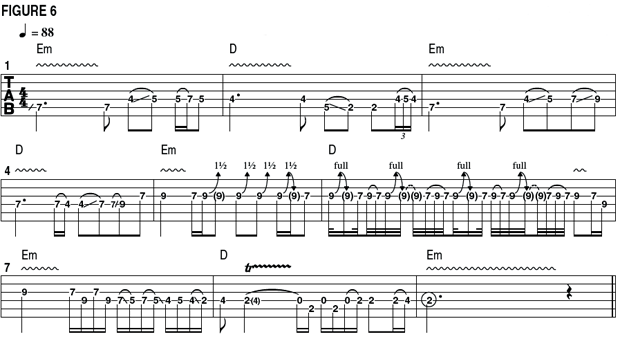
Another key aspect of Iommi’s soloing style that FIGURE 6 demonstrates is the intensity of both the pick attack and vibrato. Iommi’s playing is well-loved for its aggressive power, so lean into the lines with both hands, and listen closely to his recorded works to get a clear picture of and feel for his playing style.
Beginning on beat two of bar 5, I repeatedly bend E, third string/ninth fret, up one and one half steps (the equivalent of three frets) to G. When performing “overbends” like this, it’s even more important to harness the strength of at least two fingers, the ring and middle, if not three (the ring, middle and index). This is followed in bar 6 by fast whole-step bends that alternate with hammer-on/pull-of combinations between the seventh and ninth frets on the G string. This is a challenging lick that will take a bit of slow practice to master.
In the second half of bar 7, I borrow a signature phrasing technique of Iommi’s, with a 16th-note run that descends the E Aeolian mode in three-note groups on a single string, using pull-offs and finger slides. This type of line serves to add both rhythmic and melodic interest to a pentatonic- or mode-based solo.
FIGURE 7 offers another example of soloing in Iommi’s style, this time incorporating the detuning of one and one half steps. (All notes and chords sound in the key of C# minor, one and one half steps lower than written.) This example demonstrates Iommi’s penchant for using fast hammer-ons and pull-offs within repeated short phrases, as he does on his solo in “Supernaut” (Vol. 4).
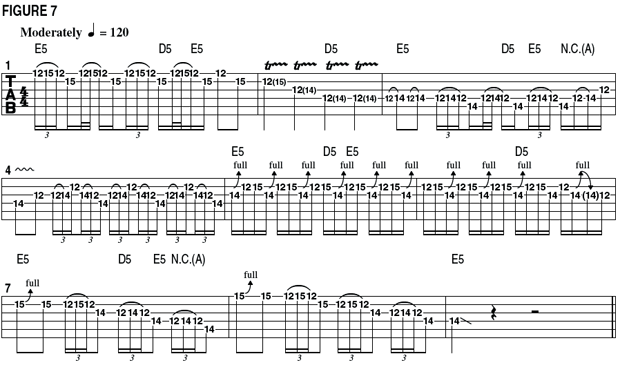
The solo is based entirely on the E minor pentatonic scale, played in 12th position, and begins with a repeated phrase that starts with a quick hammer/pull on the first string from the 12th fret to the 15th, followed by D, second string/15th fret. This sequence is played four times through bar 1, and bar 2 consists entirely of trills in 12th position. (A trill is executed by quickly alternating between two notes, usually using hammer-ons and pull-offs in combination.)
Bars 3 and 4 are similar in that both feature fast phrases based on 16th-note triplets; in bar 3, note bursts are performed with hammer/pulls on the D string, and in bar 4 the hammers occur on the G string. Bars 5 and 6 offer an example of the “threes on fours” concept—16th notes phrased in groups of three—and bars 7 and 8 wrap up the solo with fast hammer/pulls, played in 16th-nopte triplets, that traverse the strings, moving from high to low.
In all of their solos, Young, Page and Iommi combine well-structured melodic ideas, solid execution and spirited performance—essential factors in any great, memorable guitar solo that you should strive to achieve in your own solos.
Illustration: Tim O'Brien
Get The Pick Newsletter
All the latest guitar news, interviews, lessons, reviews, deals and more, direct to your inbox!
Guitar World Associate Editor Andy Aledort is recognized worldwide for his vast contributions to guitar instruction, via his many best-selling instructional DVDs, transcription books and online lessons. Andy is a regular contributor to Guitar World and Truefire, and has toured with Dickey Betts of the Allman Brothers, as well as participating in several Jimi Hendrix Tribute Tours.
"Upgrading from your entry-level acoustic opens the door to an entirely new world of tonewoods, body shapes, and brands": 6 signs it's time to upgrade from your first acoustic guitar
"I'm past my prime": 5 common excuses for not learning the guitar – and 5 body and mind-boosting reasons you should










![Joe Bonamassa [left] wears a deep blue suit and polka-dotted shirt and plays his green refin Strat; the late Irish blues legend Rory Gallagher [right] screams and inflicts some punishment on his heavily worn number one Stratocaster.](https://cdn.mos.cms.futurecdn.net/cw28h7UBcTVfTLs7p7eiLe.jpg)
